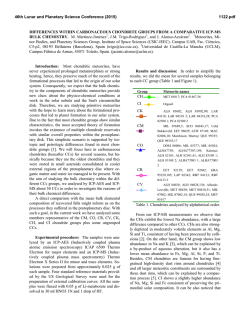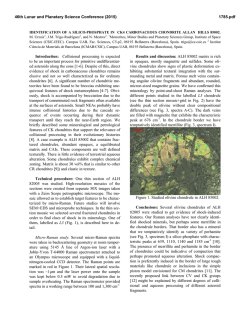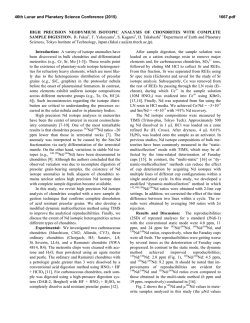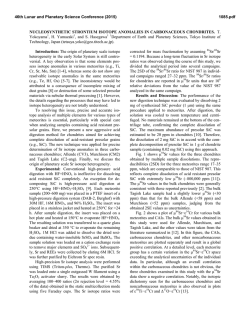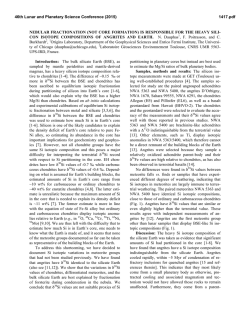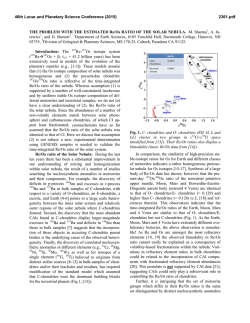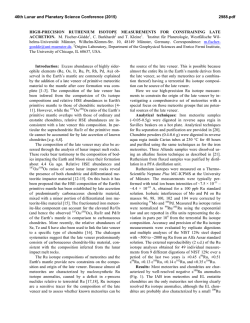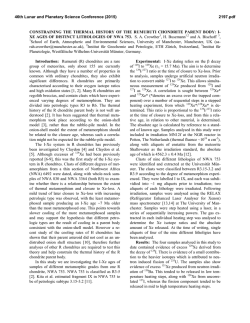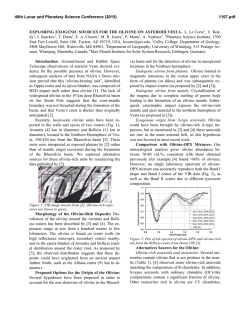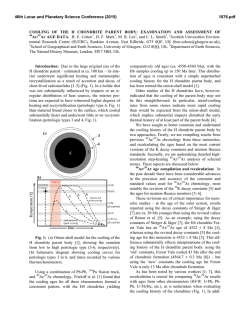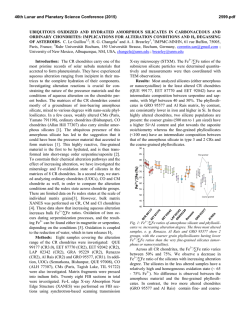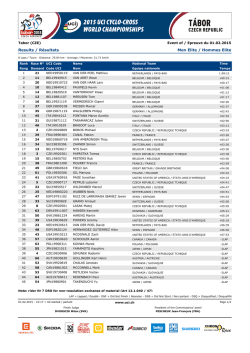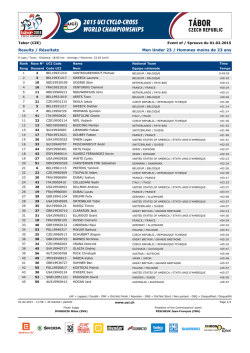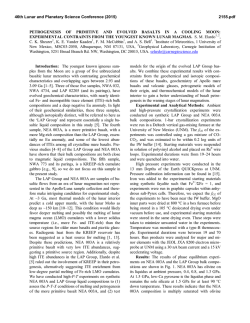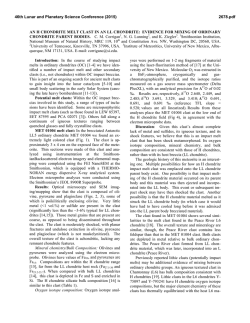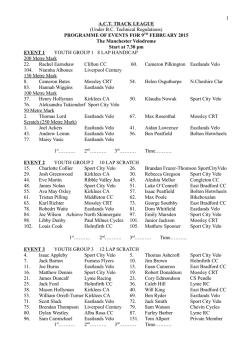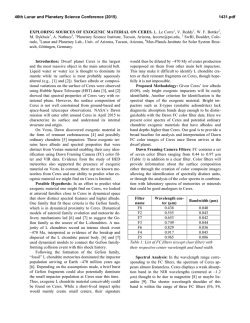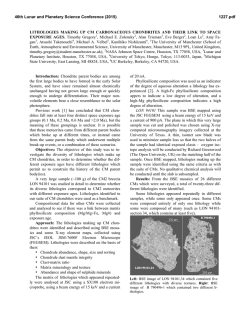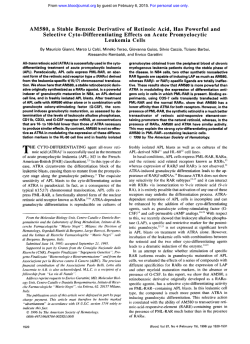
PETROLOGY AND COSMOCHEMISTRY OF A - USRA
46th Lunar and Planetary Science Conference (2015) 1229.pdf PETROLOGY AND COSMOCHEMISTRY OF A SUITE OF R CHONDRITES. Z. A. Torrano1, D. W. Mittlefehldt2, and Z. X. Peng3, 1University of Notre Dame, Notre Dame, IN 46556, USA ([email protected]) 2 Astromaterials Research Office, NASA Johnson Space Center, Houston, TX 77058, USA, 3Jacobs, NASA Johnson Space Center, Houston, TX 77058, USA. Introduction: Chondrites are among the most primitive surviving materials from the early solar system. They are divided into groups based on chemical types defined by mineralogy, bulk composition, and oxygen isotope compositions [1]. Chondrites range in petrographic grade from type 1 to type 7 [1, 2]. Type 3 chondrites are the most primitive and are little changed from the nebular solids accreted to form asteroids. They are composed of chondrules, fine-grained matrix, metal and sulfide, ±Ca-Al-rich inclusions. With increasing aqueous alteration at low temperatures, members of some chondrite classes transformed from type 3 towards type 1. With increasing thermal metamorphism and low fluid content, members of other classes changed from type 3 towards type 7. Rumuruti (R) chondrites are a rare group (0.1% of falls [3]) similar to ordinary chondrites in some properties but different in others. They are characterized by low chondrule/matrix modal abundance ratios, high oxidation state, small mean chondrule size, abundant sulfides and low metal contents [4, 5]. R chondrites vary in petrologic type from 3 to 6. They are important objects to study because some of them have undergone metamorphism at high temperatures in the presence of aqueous fluids. In contrast, CM and CI chondrites were heated to low temperatures in the presence of aqueous fluids leading to alteration; they contain low-T hydrous phases (phyllosilicates) and little or no remaining metal. Ordinary chondrites were heated to high temperatures in a low-fluid environment resulting in anhydrous metamorphic rocks. R6 chondrites are highly metamorphosed and some contain the high-T hydrous phases mica and amphibole [6, 7]. R chondrites are thus unique and give us an opportunity to examine whether there are compositional effects caused by high-T, highfluid metamorphism of nebular materials. Samples and Methods: A total of ten meteorites were analyzed, but not all techniques were used on all meteorites. Petrographic microscopy was performed, imaging and X-ray elemental mapping using a scanning electron microscope or an electron microprobe were done, and quantitative analyses of olivine, pyroxene, amphibole and mica by electron microprobe were done. Bulk rock compositions for major, minor and trace elements were done for eight samples by inductively coupled plasma mass spectrometry. Petrology and Mineral Compositions: The meteorites studied range from type R3.6 to type R6. The general mineralogy of these rocks includes olivine, pyroxene, sulfides and oxides, and for the type 6 meteorites, plagioclase, amphibole, and mica. We have done detailed petrologic and mineral composition studies of four: LAP 03639 and LAP 031156 (R4), and LAP 04840 and MIL 11207 (R6). A Mg-Ca-Al X-ray map of LAP 04840 (Fig. 1) shows its texture and heterogeneous mineral distribution. Fig 1. Elemental (Mg, Ca, Al) map of LAP 04840,45. Red – olivine, pyroxene; green – amphibole, phosphate (bright); blue – plagioclase; purple – mica (small grains); black – sulfide, magnetite. Olivine fayalite contents for four meteorites show two groupings (Fig. 2). LAP 031156 is less ferroan than the R chondrite olivine composition mode of Fa38 [8] while the other three are more ferroan. LAP 03639 contains a population of olivines of widely differing compositions, from Fa1 to Fa45, and is a breccia containing clasts of different lithologic types. LAP 031156 has a homogeneous texture, with no indication that it is a breccia. The LAP 03639 olivines near the Fa mode composition have a wider range in minor element contents, e.g. Ni, than R4 LAP 031156 olivines (Fig. 2). Fig 2. Ni vs. fayalite (Fa) for olivine grains from R chondrites. Dotted line: R chondrite Fa mode [8]. Chemistry: We have done bulk-rock analyses of two R3.8, two R4, three R6 (two are paired) and one R3.8-6 breccia. All samples plot close to mean R chondrites [9] on graphs used to distinguish different 46th Lunar and Planetary Science Conference (2015) chondrite types (e.g., Zn/Mn vs. Al/Mn; [4]). R chondrites can be susceptible to terrestrial alteration/contamination [8]. Our samples do not show evidence that their compositions have been compromised. For the most part, the alkali elements in the R chondrites are uniform. Our K contents are similar to R chondrite means [8, 9] (Fig. 3); mean Rb and Cs data have not been compiled for this group. Most R chondrite samples plot close to the literature ordinary chondrite average data for alkali elements except for R3.8 LAP 03645 and R4 LAP 03639 (Fig. 3). LAP 03645 is anomalously rich in K, Rb and Cs, but not Li or Na. LAP 03639 is similar to carbonaceous chondrites in K, Rb and Cs. However, another analysis of LAP 03639 has a K content within the range of other R chondrites [8], suggesting heterogeneous alkali-element distribution in this breccia. The amphibole- and mica-bearing R6 chondrites have alkali element contents like those of typical R3.8 and R4 chondrites. Fig 3. Rb vs. K for bulk rock R chondrites compared to chondrite means [9]. Discussion: Olivine compositions (Fig. 2) show that minor elements in LAP 03639 are much less equilibrated than in the other R4 LAP 031156. This suggests that the former is of lower petrographic grade. Further, metamorphism increases the Ni content of olivine implying oxidation during metamorphism with Ni exchanging between sulfide and olivine. We find that LAP 03639 and LAP 031156 have different olivine composition modes, and LAP 03639 contains a population of unequilibrated olivines. Our olivine data for LAP 031156 match those of [8]; that study did not present data for LAP 03639. LAP 03639 is a breccia while LAP 031156 is not. Our sections show these to be very different meteorites, contrary to the conclusion that they are of similar petrology, have similar mineral compositions, and are paired [8]. It is possible that they are paired and both meteorites are heterogeneous breccias on the cm scale, and that our sections and those of [8] are from petrologically differ- 1229.pdf ent regions of these meteorites. Pairing for these requires further evaluation. Alkali elements are soluble in aqueous solutions and easily mobilized, and are potential indicators for fluid flow in R chondrites. R3 chondrites contain primitive chondrules and fine-grained matrix [4, 5]. Alkali elements would be concentrated in chondrule glass and in matrix. In the R6 chondrites, alkali elements are contained in plagioclase, amphibole, and especially mica for the high Z alkalis, phases produced during high-T metamorphism. Thus, the alkali elements were released from nebular hosts in primitive R3 chondrites and sequestered in phases produced during metamorphism. Had there been fluid flow through the rocks, we posit there would be a fractionation of the alkali elements in R6 chondrites compared to mildly metamorphosed R3.8 and R4 chondrites. In contrast, we find that the R6 chondrites have alkali contents that are indistinguishable from those of some of the R3.8 and R4 chondrites, or the R chondrite mean for K. This suggests a lack of fluid flow through the rocks during metamorphism, and that the alkali elements now sequestered in plagioclase, amphibole and mica in R6 chondrites were locally derived from the primitive precursor lithology. While the alkali elements were mobilized by aqueous fluids and formed new minerals, they were not transported into or out of the meteorites. This is consistent with the conclusion of [8]. Key Findings: We find no evidence for element mobility during high temperature, high fluid metamorphism of R chondrites, supporting a closed-systemmetamorphism scenario. LAP 03639 is a brecciated R3.n chondrite, not a simple R4, and might not be paired with LAP 031156. Acknowledgements: We thank D. K. Ross for his efforts in acquiring backscattered electron images and X-ray elemental maps. This study was an LPI summer intern project by ZAT. References: [1] Krot A. N. et al. (2014) Treatise on Geochemistry (2nd Ed.) Holland, H. D. and Turekian, K. K. (Eds.), Elsevier, Oxford, 1-63. [2] Scott, E. R. D. and Krot A. N. (2014) Treatise on Geochemistry (2nd Ed.) Holland, H. D. and Turekian, K. K. (Eds.), Elsevier, Oxford, 65-137. [3] Bischoff A. (2001) Planet. Space Sci. 49, 769-776. [4] Kallemeyn G. W. et al. (1996) Geochim. Cosmochim. Acta, 60, 12, 2243-2256. [5] Bischoff A. et al. (2011) Chemie der Erde, 71, 101133. [6] McCanta M. C. et al. (2008) Geochim. Cosmochim. Acta, 72, 5757-5780. [7] Gross J. et al. (2013) LPS XLIV, Abstract #2212. [8] Isa J. et al. (2014) Geochim. Cosmochim. Acta, 124, 131-151. [9] Lodders K. and Fegley B. (1998) The Planetary Scientist’s Companion. Oxford University Press.
© Copyright 2026
